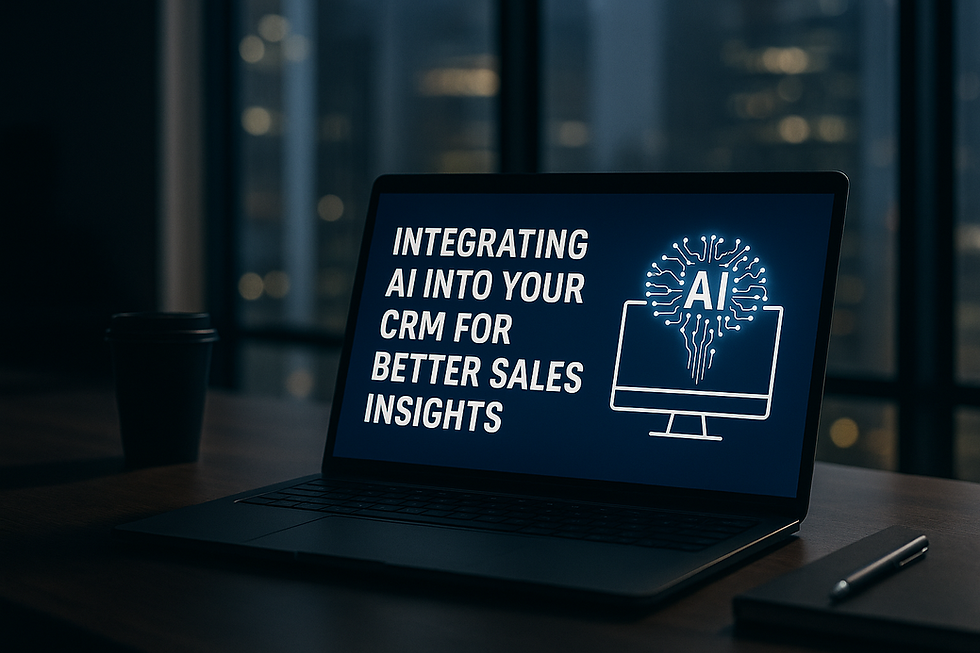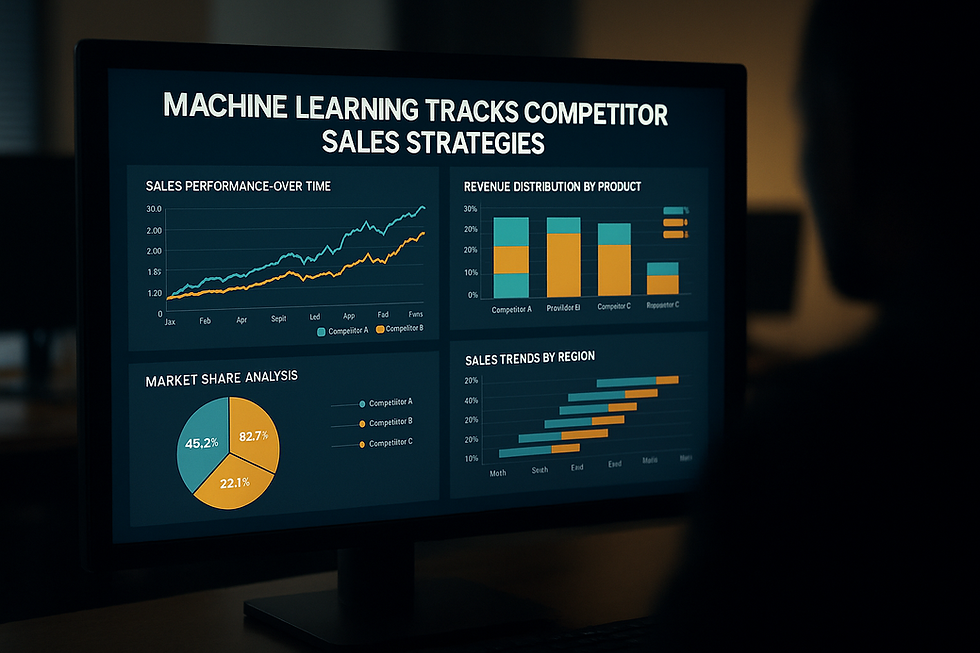Real Time Social Listening for Sales Opportunities
- Muiz As-Siddeeqi

- Aug 19
- 5 min read

Real Time Social Listening for Sales Opportunities
They’re Talking. Are You Even Listening?
When a customer posts, “I need a better CRM,” or complains, “My sales team is struggling to convert leads,” the clock starts ticking. Every second you delay in noticing and acting is a second your competitor could pounce.
And they often do.
Welcome to the brutal world of real-time social listening for sales opportunities. This isn’t just about tracking hashtags. It’s about detecting buying signals the moment they’re dropped—across LinkedIn rants, Twitter threads, Reddit discussions, YouTube comments, Instagram Stories, and even TikTok trends.
This is where sales is no longer about hunting—it's about detecting.
Let’s break down what real-time social listening actually means, why it’s becoming the most underrated weapon in modern B2B and B2C sales, and how companies are using machine learning to turn stray social chatter into pure gold.
Bonus: Machine Learning in Sales: The Ultimate Guide to Transforming Revenue with Real-Time Intelligence
When People Type, Money Talks
Every second:
Over 6,000 tweets are sent.
Around 1,000 Instagram posts are uploaded.
500+ YouTube comments go live.
Thousands of Reddit discussions evolve.
(Source: Internet Live Stats, 2024)
Hidden inside those posts are buying intents, pain points, comparison queries, customer dissatisfaction, and even calls for help.
But here’s the real punch:
A 2024 report by Deloitte found that 41% of B2B buyers said they first considered a product after seeing a social mention that wasn’t even directed at them — but was picked up by a sales rep who engaged quickly.
That’s real-time social listening done right.
What Real-Time Social Listening Actually Is (and Isn’t)
Let’s be very clear. It’s not:
Reading your own brand mentions once a week.
Looking at Twitter alerts once a day.
Collecting all posts with the word “sales” in them.
Instead, real-time social listening is:
Monitoring social conversations in real time using AI and machine learning.
Detecting unstructured data like sarcasm, slang, and sentiment shifts.
Prioritizing leads based on urgency, brand context, and buying readiness.
Alerting sales teams instantly when a relevant conversation starts.
It's not just watching. It's interpreting and acting fast.
Machine Learning: The Ears Behind the Operation
Let’s now talk tech.
How does machine learning actually power this?
Natural Language Processing (NLP)
ML models trained with NLP can detect:
Complaints ("Our CRM is just a mess lately")
Praise ("Loving HubSpot for automating follow-ups")
Confusion ("Not sure if I should go with X or Y")
Direct leads ("Need a sales solution by Friday")
Sentiment Analysis
ML doesn't just read words—it reads emotions. It scores posts in real-time:
Is this positive, neutral, or negative?
How intense is the feeling?
Is this a joke or serious?
Named Entity Recognition (NER)
The system highlights:
Company names
Product names
Competitor brands
Locations
Influencers involved
Behavioral Patterns
Over time, ML maps user behavior. For example:
A lead who’s been comparing three CRMs over five posts
A company that switched tools recently
A founder suddenly talking about hiring sales reps = growth opportunity
This is machine learning detecting sales-ready patterns from human emotion and context.
A Brutal Truth: 70% of Companies Are Blind
According to a 2023 Gartner survey:
“70% of sales teams fail to leverage real-time social data in prospecting, despite 61% of prospects making tool decisions based on peer social validation.”
This means most companies are deaf to the world's biggest sales opportunity: unsolicited conversations happening around their industry.
And that’s tragic.
Because your ideal customer might be shouting, "Help!"… but no one’s listening.
Real Case Studies: Who’s Doing It Right
Dell Technologies
Dell used Sprinklr’s AI-powered listening tool across Twitter, Reddit, and LinkedIn. Within 3 months in 2023, they reported:
A 23% rise in inbound leads
17% faster sales cycles
And, critically, increased conversions from pain-based leads—leads that came from customer frustrations on social media.
(Source: Sprinklr x Dell Case Study, 2023)
Salesforce
In a public webinar in 2023, Salesforce revealed how their internal ML-based tool detected a spike in tweets complaining about slow lead tracking. Many of these mentions didn’t tag any CRM.
Their reps reached out within minutes, offering tailored demos. The result?
A 19% conversion rate from cold Twitter leads—triple their standard rate.
(Source: Salesforce AI Webinar 2023)
Hootsuite
Hootsuite integrated sentiment detection and pain-point extraction into their own tool stack. In Q1 2024, they landed $3.1M worth of mid-market contracts from conversations where they were never tagged—just detected by real-time NLP.
(Source: Hootsuite Annual Report 2024, p. 47)
The Invisible Funnel: From Tweet to Closed Deal
Let’s map how social listening becomes sales:
A prospect posts: “Struggling to track leads efficiently… anyone using a good CRM?”
ML model detects the post instantly (unstructured, emotional, pain-driven).
Sales team is notified: profile history, pain level, urgency score, relevance to solution.
Rep engages within 5 minutes: “Hey, we help companies like yours simplify lead tracking. Want a free walkthrough?”
Prospect responds.
48 hours later: Qualified demo.
2 weeks later: Closed deal.
This isn’t science fiction.
It’s 100% real. And it’s happening right now.
Beyond Mentions: Listening to Competitor Pain Too
Here’s where it gets spicy.
Real-time listening isn’t just about your brand. It’s about:
Competitor hate: “We’re leaving [X company], horrible onboarding.”
Industry gaps: “Tried 3 tools, none work well for retail sales.”
Shifting markets: “Looking for AI sales help in LATAM. Suggestions?”
Every one of these is a sales trigger—waiting to be claimed.
And if your reps aren’t alerted within seconds, your competitors will.
Tools That Make It Happen
Here are real, enterprise-ready, ML-powered tools being used today:
Tool | Key ML Features | Used By |
Sprinklr | Sentiment detection, contextual alerting | Dell, Microsoft |
Brandwatch | Crisis detection, behavioral tracking | Unilever, GSK |
Talkwalker | Visual listening + text analysis | Adidas, Nissan |
Crimson Hexagon (now part of Brandwatch) | Historical trend mapping | P&G, Netflix |
Awario | Boolean-driven real-time keyword monitoring | SMBs, SaaS startups |
Meltwater | Real-time alerts, influencer detection | Coca-Cola, Accenture |
Each one uses documented machine learning models trained on millions of social conversations.
How to Build a Listening Strategy That Actually Converts
Here’s what the most successful companies do:
Train models on your ICP pain points
“Need CRM help”
“Struggling with pipeline visibility”
“Looking for AI in sales”
“Too expensive sales tool”
Add context triggers
Competitor names
Locations
Job titles: VP Sales, RevOps, Demand Gen
Score leads based on urgency + buying intent
Complaints = hot
Praise = warm
Jokes = low (but still insightful)
Build workflows
ML triggers → Slack ping → CRM ticket → Instant rep outreach
Integrate with CRM
Auto-log interactions
Track social-first conversions
Optimize engagement windows
Reports and News Backing This Up
Gartner (2023): 61% of sales decisions influenced by peer social discussions.
Deloitte Insights (2024): 44% of marketing-qualified leads come from social mentions.
McKinsey Digital (2023): Real-time social listening improves time-to-response by 72%, increasing close rates by up to 35%.
Forrester Research (2024): Companies using AI-powered social listening close 22% more deals in competitive industries.
The Harsh Reality: Sales Is Now Public
People don't ask for product brochures anymore.
They tweet. They vent. They explore. Publicly.
And whoever shows up first in that comment section—wins.
That’s what makes real-time social listening for sales not just a strategy, but a competitive necessity.
Final Words (And A Bit of Tough Love)
If you're not listening to your prospects right now, in real time, someone else is.
And they’re converting the deals that could’ve been yours.
You already have everything you need:
Tools with ML
Public data
Buying signals everywhere
What you need now is urgency.
So tune in. Train your models. Wake up your sales reps.
Because the conversation is already happening. And your name? It’s either being mentioned—or being ignored.

$50
Product Title
Product Details goes here with the simple product description and more information can be seen by clicking the see more button. Product Details goes here with the simple product description and more information can be seen by clicking the see more button

$50
Product Title
Product Details goes here with the simple product description and more information can be seen by clicking the see more button. Product Details goes here with the simple product description and more information can be seen by clicking the see more button.

$50
Product Title
Product Details goes here with the simple product description and more information can be seen by clicking the see more button. Product Details goes here with the simple product description and more information can be seen by clicking the see more button.






Comments